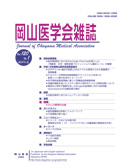

Journal of Okayama Medical Association
Published by Okayama Medical Association<Availability>
Full-text articles are available 3 years after publication.
Permalink : http://escholarship.lib.okayama-u.ac.jp/16832
脳浮腫における局所頭蓋内圧差発生に関する実験的研究
二宮 一彦
岡山大学医学部脳神経外科
発行日
1979-04-30
抄録
The present studies were designed to determine whether significant pressure differences between hemispheres occur in response to cold-induced cerebral edema and if so, their response to induced high intracranial pressure. The experiments were carried out on 35 adult mongrel dogs weighing between 8 to 12kg under intraperitoneal pentobarbital anesthesia. A cold-induced edema was produced at the left frontal lobe by placing a metallic cylinder filled with liquid nitrogen on the exposed dura mater for 5 minutes. Subdural pressures were recorded continuously for 12 hours from the subdural spaces over the left parietal lobe adjacent to the cold injury and the right parietal lobe remote to the injury, using microballoons or Fiber-optic pressure switch sensors through burr holes. Cisterns magna pressure was also continuously measured with a needle inserted into the cisterna magna by percutaneous puncture. In addition, during progressing cerebral edema, intracranial pressure was investigated after the injection of saline solution into the cisterna magna at 1000 mm hydrostatic pressure at 3, 6 and 12 hours after cold injury. Three hours after cold injury, the subdural pressure of the left injured hemisphere was higher than that of the right non-injured one. About 6-9 hours following injury, pressure differences between injured and non-injured hemispheres showed maximal values ranging from 40 to 160 mm H(2)O (3-11.8 mmHg). Intracranial pressure had increased markedly. by 9 hours after cold injury, at which time such pressure differences decreased gradually. In the late stage of edema, however, intracranial pressure was distributed equally throughout the entire brain, so that pressure differences had disappeared. The changes in intracranial pressure after injection of saline revealed a biphasic pattern about 3 hours after injury as compared with the normal. At 12 hours, elevated intracranial pressure after injection did not return to the previous resting level. These phenomina suggest that the initial steep drop represented intracranial volumetric compensation by the intracranial and spinal coverings and venous system in the central nervous system, and that the late gentle slope represented impairment of cerebrospinal fluid absorption. These results indicated at least two possible explanations for the origin of pressure differences : 1) reduction of the pressure compensating capacity of the injured swollen hemisphere blocking the free communication of cerebrospinal fluid and collapsed venous system, 2) delayed transmission of the elevated pressure from the lesion to the noninjured hemisphere because of local change in viscoelasticity. Accordingly, changes in pressure differences as well as the height of intracranial pressure would play a major role in the pathophysiology of an expanding lesion.
キーワード
cold-induced edema
subdural pressure
intracranial pressure difference
cisterna magna pressure
ISSN
0030-1558
NCID
AN00032489
